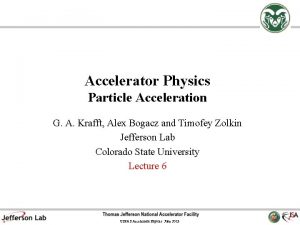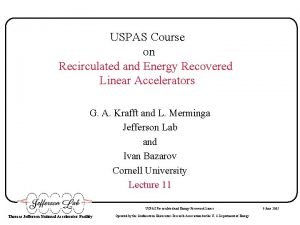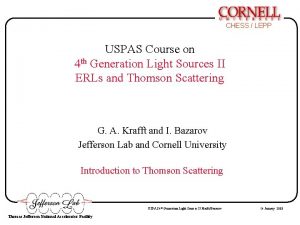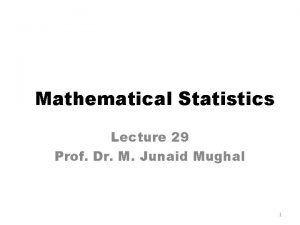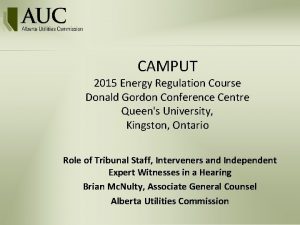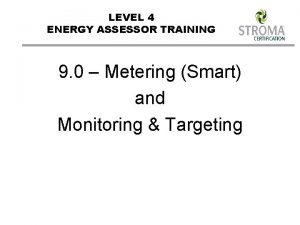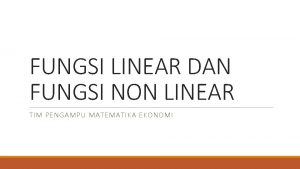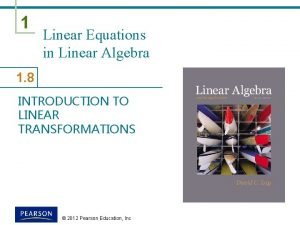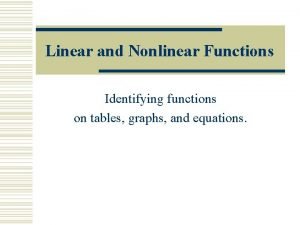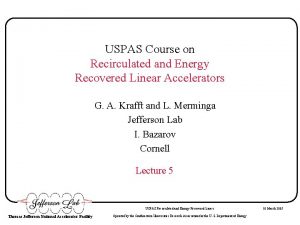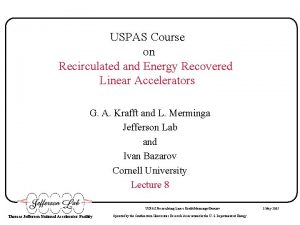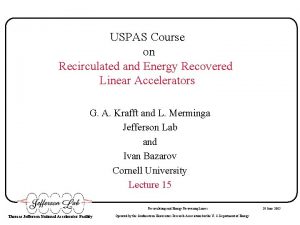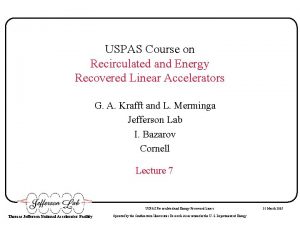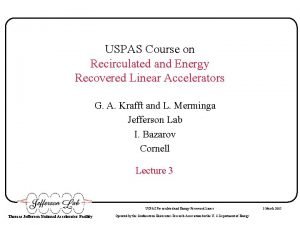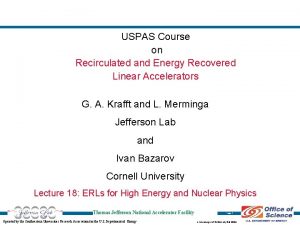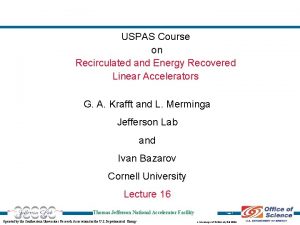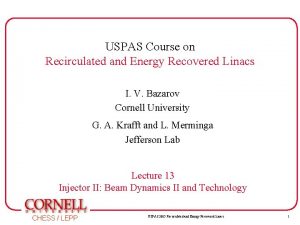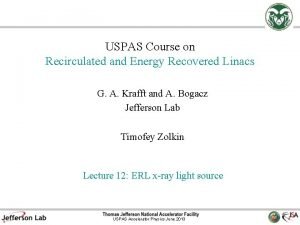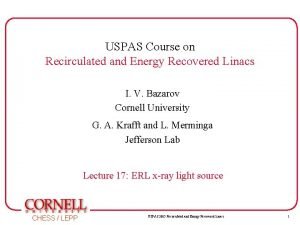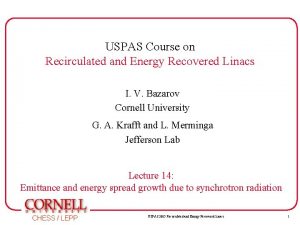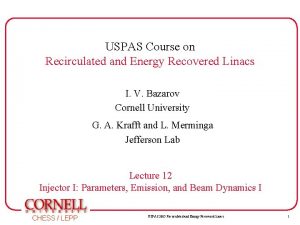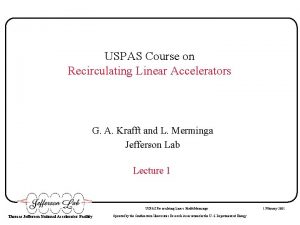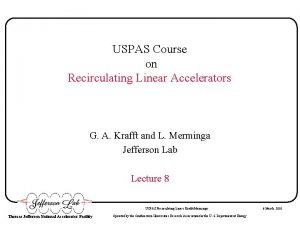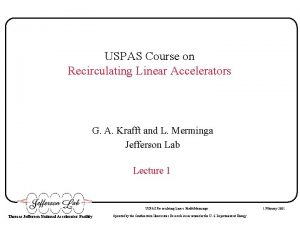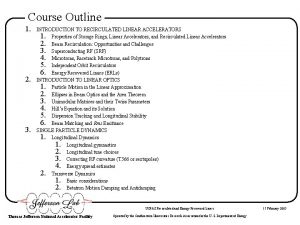USPAS Course on Recirculated and Energy Recovered Linear






































- Slides: 38

USPAS Course on Recirculated and Energy Recovered Linear Accelerators G. A. Krafft and L. Merminga Jefferson Lab I. Bazarov Cornell Lecture 9 USPAS Recirculated and Energy Recovered Linacs Thomas Jefferson National Accelerator Facility Operated by the Southeastern Universities Research Association for the U. S. Department of Energy 29 April 2005

Energy Spread, Intrinsic Phase Spread Intrinsic Energy Spread Set in injector/initial bunching USPAS Recirculated and Energy Recovered Linacs Thomas Jefferson National Accelerator Facility Operated by the Southeastern Universities Research Association for the U. S. Department of Energy 29 April 2005

Longitudinal Optimization Energy spread from perfectly phased linac Using definition of longitudinal emittance, derive an optimum And minimum energy spread out the end USPAS Recirculated and Energy Recovered Linacs Thomas Jefferson National Accelerator Facility Operated by the Southeastern Universities Research Association for the U. S. Department of Energy 29 April 2005

Longitudinal Optimization Measurements of longitudinal emittance Injector 45 Me. V <6. 7 ke. V deg Nlinac exit 500 Me. V <12. 5 ke. V deg Optimal spread using larger number 2 E-5 @ 1 Ge. V (5 E-6 @ 4 Ge. V) USPAS Recirculated and Energy Recovered Linacs Thomas Jefferson National Accelerator Facility Operated by the Southeastern Universities Research Association for the U. S. Department of Energy 29 April 2005

RF Focussing In any RF cavity that accelerates longitudinally, because of Maxwell Equations there must be additional transverse electromagnetic fields. These fields will act to focus the beam and must be accounted properly in the beam optics, especially in the low energy regions of the accelerator. We will discuss this problem in greater depth in injector lectures. Let A(x, y, z) be the vector potential describing the longitudinal mode (Lorenz gauge) USPAS Recirculated and Energy Recovered Linacs Thomas Jefferson National Accelerator Facility Operated by the Southeastern Universities Research Association for the U. S. Department of Energy 29 April 2005

For cylindrically symmetrical accelerating mode, functional form can only depend on r and z Maxwell’s Equations give recurrence formulas for succeeding approximations USPAS Recirculated and Energy Recovered Linacs Thomas Jefferson National Accelerator Facility Operated by the Southeastern Universities Research Association for the U. S. Department of Energy 29 April 2005

Gauge condition satisfied when in the particular case n = 0 Electric field is USPAS Recirculated and Energy Recovered Linacs Thomas Jefferson National Accelerator Facility Operated by the Southeastern Universities Research Association for the U. S. Department of Energy 29 April 2005

And the potential and vector potential must satisfy So the magnetic field off axis may be expressed directly in terms of the electric field on axis USPAS Recirculated and Energy Recovered Linacs Thomas Jefferson National Accelerator Facility Operated by the Southeastern Universities Research Association for the U. S. Department of Energy 29 April 2005

And likewise for the radial electric field (see also ) Explicitly, for the time dependence cos(ωt + δ) USPAS Recirculated and Energy Recovered Linacs Thomas Jefferson National Accelerator Facility Operated by the Southeastern Universities Research Association for the U. S. Department of Energy 29 April 2005

USPAS Recirculated and Energy Recovered Linacs Thomas Jefferson National Accelerator Facility Operated by the Southeastern Universities Research Association for the U. S. Department of Energy 29 April 2005

USPAS Recirculated and Energy Recovered Linacs Thomas Jefferson National Accelerator Facility Operated by the Southeastern Universities Research Association for the U. S. Department of Energy 29 April 2005

USPAS Recirculated and Energy Recovered Linacs Thomas Jefferson National Accelerator Facility Operated by the Southeastern Universities Research Association for the U. S. Department of Energy 29 April 2005

Motion of a particle in this EM field USPAS Recirculated and Energy Recovered Linacs Thomas Jefferson National Accelerator Facility Operated by the Southeastern Universities Research Association for the U. S. Department of Energy 29 April 2005

The normalized gradient is and the other quantities are calculated with the integral equations USPAS Recirculated and Energy Recovered Linacs Thomas Jefferson National Accelerator Facility Operated by the Southeastern Universities Research Association for the U. S. Department of Energy 29 April 2005

These equations may be integrated numerically using the cylindrically symmetric CEBAF field model to form the Douglas model of the cavity focussing. In the high energy limit the expressions simplify. USPAS Recirculated and Energy Recovered Linacs Thomas Jefferson National Accelerator Facility Operated by the Southeastern Universities Research Association for the U. S. Department of Energy 29 April 2005

USPAS Recirculated and Energy Recovered Linacs Thomas Jefferson National Accelerator Facility Operated by the Southeastern Universities Research Association for the U. S. Department of Energy 29 April 2005

Transfer Matrix For position-momentum transfer matrix USPAS Recirculated and Energy Recovered Linacs Thomas Jefferson National Accelerator Facility Operated by the Southeastern Universities Research Association for the U. S. Department of Energy 29 April 2005

Kick Generated by mis-alignment USPAS Recirculated and Energy Recovered Linacs Thomas Jefferson National Accelerator Facility Operated by the Southeastern Universities Research Association for the U. S. Department of Energy 29 April 2005

Damping and Antidamping By symmetry, if electron traverses the cavity exactly on axis, there is no transverse deflection of the particle, but there is an energy increase. By conservation of transverse momentum, there must be a decrease of the phase space area. For linacs NEVER use the word “adiabatic” USPAS Recirculated and Energy Recovered Linacs Thomas Jefferson National Accelerator Facility Operated by the Southeastern Universities Research Association for the U. S. Department of Energy 29 April 2005

Conservation law applied to angles USPAS Recirculated and Energy Recovered Linacs Thomas Jefferson National Accelerator Facility Operated by the Southeastern Universities Research Association for the U. S. Department of Energy 29 April 2005

Phase space area transformation Therefore, if the beam is accelerating, the phase space area after the cavity is less than that before the cavity and if the beam is decelerating the phase space area is greater than the area before the cavity. The determinate of the transformation carrying the phase space through the cavity has determinate equal to USPAS Recirculated and Energy Recovered Linacs Thomas Jefferson National Accelerator Facility Operated by the Southeastern Universities Research Association for the U. S. Department of Energy 29 April 2005

By concatenation of the transfer matrices of all the accelerating or decelerating cavities in the recirculated linac, and by the fact that the determinate of the product of two matrices is the product of the determinates, the phase space area at each location in the linac is Same type of argument shows that things like orbit fluctuations are damped/amplified by acceleration/deceleration. USPAS Recirculated and Energy Recovered Linacs Thomas Jefferson National Accelerator Facility Operated by the Southeastern Universities Research Association for the U. S. Department of Energy 29 April 2005

Summary of last three lectures We have shown how proper manipulation of the longitudinal phase space can lead to accelerators with superior beam characteristics. We have shown how phase space tends to be degraded by generation of “curvatures” in longitudinal phase space, and a means to quantify such effects. In this lecture and the preceding one, we’ve discussed some of the ways that people have combated this effect through (1) proper RF phase choices, (2) adding sextupoles in recirculation optics, and (3) RF linearization cavities. We’ve demonstrated in more detail estimated the energy spread generated by the effect of RF amplitude and phase fluctuations. USPAS Recirculated and Energy Recovered Linacs Thomas Jefferson National Accelerator Facility Operated by the Southeastern Universities Research Association for the U. S. Department of Energy 29 April 2005

We’ve shown a method to estimate the RF focussing from the accelerating modes of the linear accelerator. This method has been used to determine some of the “standard” transfer matrices of cavities. We’ve calculated the effect of damping and antidamping of betatron oscillations in a linac accelerating or decelerating. USPAS Recirculated and Energy Recovered Linacs Thomas Jefferson National Accelerator Facility Operated by the Southeastern Universities Research Association for the U. S. Department of Energy 29 April 2005

Optics Issues for Recirculating Linacs E E E f f f E E f f D. Douglas USPAS Recirculated and Energy Recovered Linacs Thomas Jefferson National Accelerator Facility Operated by the Southeastern Universities Research Association for the U. S. Department of Energy 29 April 2005

The Naïve Recirculator. Injector • Linac • accelerating sections • focussing • Recirculator – bending & focussing • Beam goes around & around, is accelerated/decelerated as needed for the application at hand USPAS Recirculated and Energy Recovered Linacs Thomas Jefferson National Accelerator Facility Operated by the Southeastern Universities Research Association for the U. S. Department of Energy 29 April 2005

Multipass Focussing In Linac(s) Beam envelope/spot size control is the transverse optical issue in recirculating linacs. Recirculation leads to mismatch between beam energy and excitation of focusing . elements. set focusing for first pass higher passes get “no” focusing/blow up (linac looks like a drift, bmax ~ linac length). set focusing for higher passes first pass over-focused/blows up. Large envelopes lead to scraping, error sensitivity, lower instability thresholds Imposes limits on. injection energy (higher is better but costs more), . linac length (shorter is better but gives less acceleration), and/or. achievable control over bmax USPAS Recirculated and Energy Recovered Linacs Thomas Jefferson National Accelerator Facility Operated by the Southeastern Universities Research Association for the U. S. Department of Energy 29 April 2005

CEBAF Envelopes – FODO quad lattice with 120 o phase advance on 1 st pass USPAS Recirculated and Energy Recovered Linacs Thomas Jefferson National Accelerator Facility Operated by the Southeastern Universities Research Association for the U. S. Department of Energy 29 April 2005

Panaceas . Focus 1 st pass as much as possible (whilst maintaining adequate betatron stability) . Use a “split linac” – 2 halves rather than 1 whole. Shorter linac lower peak envelopes (“shorter drift length”) Linac interruptus High injection energy “Graded gradient” focusing in energy-recovering linacs Use high gradient RF Use an “inventive” linac topology. “Counter-rotated” linacs. “Bisected” linac topology. “Asymmetric” linac topology . . . USPAS Recirculated and Energy Recovered Linacs Thomas Jefferson National Accelerator Facility Operated by the Southeastern Universities Research Association for the U. S. Department of Energy 29 April 2005

CEBAF Envelopes, reduced focusing – FODO quad lattice with 60 o phase advance on 1 st pass USPAS Recirculated and Energy Recovered Linacs Thomas Jefferson National Accelerator Facility Operated by the Southeastern Universities Research Association for the U. S. Department of Energy 29 April 2005

Injection Energy . . . Injection energy “must” be high enough to avoid significant levels of pass-to-pass RF phase slip. CEBAF Einj = 45 Me. V, df. RF ~ 1 -2 o on 1 st pass, little thereafter. IR Demo FEL Einj = 10 Me. V, df. RF ~ 10 o from pass to pass Injection energy “should” be high enough to allow adequate pass-to-pass focusing in a single transport system. “adequate” is system dependent. CEBAF (45 Me. V 4 Ge. V): bmax ~ 200 m – adequate to run 200 m. A. IR Demo (10 Me. V 45 Me. V): bmax ~ 25 m – adequate to run 5 m. A. Higher is better (front end focusing elements stronger) but more expensive. SUPERCEBAF (1 Ge. V 16 Ge. V), using same type of linac focusing as in CEBAF: bmax ~ 130 m Naïve figure of merit: Efinal/Einj, with smaller being better USPAS Recirculated and Energy Recovered Linacs Thomas Jefferson National Accelerator Facility Operated by the Southeastern Universities Research Association for the U. S. Department of Energy 29 April 2005

“Graded-gradient” Focusing . . . There are 2 common focusing patterns: . constant gradient (all quads have same pole tip field; sometimes used in microtrons). constant focal length (quad excitation tracks energy; often used in linacs) Neither works well for energy recovering linacs. Beam envelopes blow up, limiting linac length & tolerable Efinal: Ein ratio “Graded-gradient” focusing match focal length of quads to beam of lowest energy. Excitation of focusing elements increases with energy to linac midpoint, then declines to linac end. Allows “exact” match for half of linac, produces “adiabatically induced” mismatch in second half USPAS Recirculated and Energy Recovered Linacs Thomas Jefferson National Accelerator Facility Operated by the Southeastern Universities Research Association for the U. S. Department of Energy 29 April 2005

“Graded-gradient” Focusing, cont. 1 km, 10 Me. V 10 Ge. V linac (111 MV/module), triplet focusing: recirculator 222 MV USPAS Recirculated and Energy Recovered Linacs Thomas Jefferson National Accelerator Facility Operated by the Southeastern Universities Research Association for the U. S. Department of Energy 29 April 2005

High Accelerating Gradient . Higher accelerating gradient very helpful in limiting beam envelope mismatch. Shortens linac. Increases excitation of front end (after 1 st accelerating section) focusing elements, reducing mismatch on higher passes. ½ km 10 Me. V 10 Ge. V linac (~222 MV/module), using triplets: recirculator 111 MV USPAS Recirculated and Energy Recovered Linacs Thomas Jefferson National Accelerator Facility Operated by the Southeastern Universities Research Association for the U. S. Department of Energy 29 April 2005

High Accelerating Gradient, cont. . “Focal Failure Factor”. Ratio of energies after 1 st/before final accelerating section. Figure of merit for multipass mismatch – more descriptive than ratio of injected to final energies. For the two example machines: Average Gradient E after 1 st 111 Me. V/module 121 Me. V 222 Me. V/module 232 Me. V E before last“FFF” 9889 Me. V ~82 9778 Me. V ~42 (compare to Eout/Ein = 1000…) USPAS Recirculated and Energy Recovered Linacs Thomas Jefferson National Accelerator Facility Operated by the Southeastern Universities Research Association for the U. S. Department of Energy 29 April 2005

Why it Matters (“Halo”) Performance of recirculated linacs may ultimately be limited by loss of “halo” – particles far from the beam core . . . There is “stuff” in the beam not necessarily well described by core emittance, rms spot sizes, gaussian tails, etc. This “stuff” represents a small fraction (<10 -4 ? 10 -5 ? ) of the total current, but it can get scraped away locally, causing heating, activation, and damaging components Heuristically: . Higher current leads to more such loss. Smaller beam pipe results in greater loss. Bigger beam envelopes encourage increased loss USPAS Recirculated and Energy Recovered Linacs Thomas Jefferson National Accelerator Facility Operated by the Southeastern Universities Research Association for the U. S. Department of Energy 29 April 2005

Phenomenology . . . In CEBAF, BLM/BCMs induced trips losses of ~1 m. A out of 100 m. A in 1 cm aperture where b ~100 m proportionality const. ~ (1 m. A/100 m. A)x (0. 01 m/100 m) ~ 10 -6 In the IR Demo FEL, BLMs induce trips losses of ~ 1 m. A out of 5000 m. A in 2. 5 cm aperture where b ~5 m proportionality const. ~ (1 m. A/5000 m. A)x (0. 025 m/5 m) ~ 10 -6 One might then guess which, in a 100 m. A machine tolerating 5 m. A loss in a 2. 5 cm bore, implies you must have b ~ 1. 25 m (ouch!) Moral: There will be great virtue in clean beam and small beam envelope function values! USPAS Recirculated and Energy Recovered Linacs Thomas Jefferson National Accelerator Facility Operated by the Southeastern Universities Research Association for the U. S. Department of Energy 29 April 2005

. Recirculation arc design. Functional modularity. Beam separation (extraction)/recombination (reinjection) geometry. Single step. Staircase. Overshoot. Beam quality preservation. Incoherent synchrotron radiation control. Energy spread ~g 5/r 2. Emittance excitation ~ <H>g 7/r 2, H ~ b 2, h 2. CSR control & compensation (e. g ½ betatron wavelength correction in IR Demo; don’t squeeze entire phase at one time; keep betas, etas small). Space charge control (don’t squeeze entire phase space at one time). Matching. Transverse – linac to recirculator, vice versa. Longitudinal phase space management. Orthogonal knobs useful: e. g. IR Demo – path length, M 56, T 566 all decoupled & more or less separate from transverse USPAS Recirculated and Energy Recovered Linacs Thomas Jefferson National Accelerator Facility Operated by the Southeastern Universities Research Association for the U. S. Department of Energy 29 April 2005
 Uspas sport
Uspas sport Uspas
Uspas Uspas
Uspas Energy energy transfer and general energy analysis
Energy energy transfer and general energy analysis Energy energy transfer and general energy analysis
Energy energy transfer and general energy analysis Course title and course number
Course title and course number Which is not the “effect of accident on worker”
Which is not the “effect of accident on worker” Recovered memory 17
Recovered memory 17 Royalty a/c
Royalty a/c Dr junaid mughal
Dr junaid mughal Half brick wall vs one brick wall
Half brick wall vs one brick wall Chaine parallèle muscle
Chaine parallèle muscle Linear regression vs multiple regression
Linear regression vs multiple regression Another word for symbol
Another word for symbol Nonlinear narrative definition
Nonlinear narrative definition Non linear pipeline processor
Non linear pipeline processor Define multimedia
Define multimedia Linear impulse equation
Linear impulse equation Persamaan linear simultan
Persamaan linear simultan Convert right linear grammar to left linear grammar
Convert right linear grammar to left linear grammar Difference between linear and nonlinear equation
Difference between linear and nonlinear equation Persamaan linear simultan
Persamaan linear simultan Camput energy regulation course
Camput energy regulation course Energy assessor training
Energy assessor training Metode biseksi contoh soal
Metode biseksi contoh soal Contoh soal persamaan non linier metode biseksi
Contoh soal persamaan non linier metode biseksi Fungsi linear dan non linear matematika ekonomi
Fungsi linear dan non linear matematika ekonomi Apa yang dimaksud dengan fungsi non linier?
Apa yang dimaksud dengan fungsi non linier? Linear independence of vectors
Linear independence of vectors Linear algebra linear transformation
Linear algebra linear transformation Lereng dan penggal garis
Lereng dan penggal garis Linear vs nonlinear tables
Linear vs nonlinear tables Linear and nonlinear tables
Linear and nonlinear tables Linear editing vs non linear editing
Linear editing vs non linear editing Closure properties of regular languages
Closure properties of regular languages Exemplo de texto narrativo
Exemplo de texto narrativo Section 2 describing energy worksheet answers
Section 2 describing energy worksheet answers Primary energy and secondary energy
Primary energy and secondary energy Primary energy and secondary energy
Primary energy and secondary energy
